
Buren is a town and municipality in the Betuwe region of the Netherlands. Buren has 27,168 inhabitants as of 1 January 2022.

Maria van Arkel was the only daughter and heiress of Lord John V of Arkel and Joanna of Jülich. She inherited the title to Gelderland from her maternal uncle, Duke Reginald IV, and her son became Arnold, Duke of Gelderland. She was the paternal grandmother of Mary of Guelders, who became Queen of Scots.
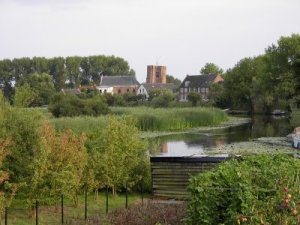
Acquoy is a village in the Dutch province of Gelderland. It is a part of the municipality of West Betuwe, and lies about 12 km (7 mi) east of Gorinchem.

Echteld is a village in the Dutch province of Gelderland. It is a part of the municipality of Neder-Betuwe, and lies about 6 km east of Tiel.
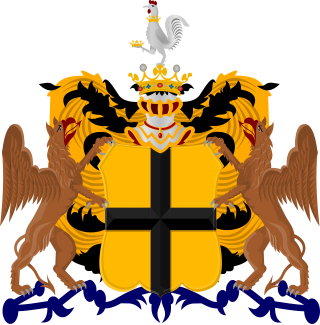
the House of Bylandt is the name of an ancient house of nobility originating in the Lower Rhine region. It later split into the cadet branches of Bylandt-Well, Bylandt-Rheydt and Bylandt-Halt-Spaldorf.

William was Duke of Guelders, as William I, from 1377 and Duke of Jülich, as William III, from 1393. William was known for his military activities, participating in the Prussian crusade five times and battling with neighbors in France and Brabant throughout his rule. His allies included Holy Roman Emperors, Charles IV and Wenceslaus, Richard II of England, and Conrad Zöllner von Rothenstein, the Grand Master of the Teutonic Knights. During his reign the duchies of Guelders and Jülich were temporarily unified.
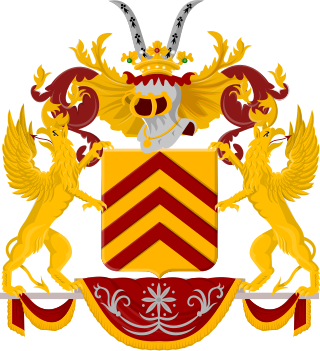
The van Voorst tot Voorst family is an old Dutch noble family from the province of Overijssel.

The Van Renesse family is an old Dutch noble family and cadet branch of the Van Voorne Family that stems from the town of Renesse in Zeeland.

The Lords of Brederode were a noble family from Holland who played an important role during the Middle Ages and the Early modern period. The family had a high noble rank and hold the titles Count of Brederode, Count of Gennep, and furthermore they ruled the souverain Lordship of Vianen, the Viscountship of Utrecht among other feudal titles.
The Land van Arkel was a fief of the Counts of Holland, and was managed by the Lords of Arkel until 1412. The territory was bordered by the river Merwede on the south, and the river Linge on the east. The northern border might have reached as far as Everdingen, and the western border to the river Lek. Present-day towns in the territory include Leerdam, Arkel, Heukelum, Asperen, Hagestein, Haastrecht and Gorinchem.

Willem Anne Assueer Jacob Schimmelpenninck van der Oye was a Dutch baron and politician. He was president of the senate of the Netherlands from 1888 till his death in 1889.

Jonkvrouwe (Lady) Cornélie Caroline "Cox" van Asch van Wijck was a Dutch artist and sculptor.
Richardis of Bavaria was a German noblewoman. She was a daughter of Count Palatine Otto I of Bavaria, who later became the first Wittelsbach Duke of Bavaria, and his wife Agnes of Loon.
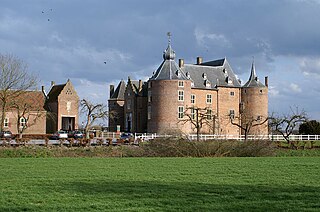
Ammersoyen Castle is located in Ammerzoden in the Bommelerwaard region in the province of Gelderland, the Netherlands. When the original construction of the castle occurred is unclear; some sources claim it was as early as the 12th century. However, the consensus among historians is that the Van Herlaer family completed the castle in the 1350s. At the time of its construction, the castle was built along a branch of the river Maas. Just a few years after the construction of the castle was completed, the river was rerouted leaving the castle to be surrounded by a moat.
Teisterbant was a pagus (province) of Lotharingia/Middle Francia. It was located in the present-day Netherlands, bordered by the rivers Lek and Waal. Modern-day West-Betuwe shares most of the same land including towns such as Batenburg, Vianen, Tiel, Culemborg, Geldermalsen. The historic fiefdoms of Altena, Arkel, Buren, Heusden and Vianen were also part of it.

Keppel Castle is a castle in the town of Laag-Keppel in the municipality of Bronckhorst, in the Dutch province of Gelderland. The castle stands on an island between two branches of the Oude IJssel. The current building was rebuilt in the 17th century after it was destroyed in 1582.

Dirk Loef of Horne was a medieval nobleman.

Dietrich IV of Limburg Hohenlimburg, born around 1375, was the second son Diederik III count of Limburg Hohenlimburg and Broich and Lukardis of Broich. He had an older sister Elisabeth and brother Willem I. Elisabeth married Dietrich IV of Volmestein. Willem married Metza of Reifferscheidt Erbin of Bedburg. Dietrich IV married Henrica of Wisch on 3 February 1415. Her father bannerlord Hendrik of Wisch and mother Elisabeth of Bronkhorst belonged to the most important nobility in Gelre. The bannerlords of Wisch had their castle Wisch on the old IJssel near Terborg.. Henrica had one younger sister Elisabeth married to Johan of Volmarstein. This created a double family ties between the Lower Rhine families Of Limburg, Of Volmarstein and the Gueldrian Of Wisch.

The lordship of Culemborg, elevated to a county in 1555, in the current province of Gelderland, was an independent polity that until 1720 was in principle not part of the Dutch Republic, but in practice was largely dependent on it. It consisted of the city of Culemborg and the villages of Everdingen, Goilberdingen and Zijderveld.
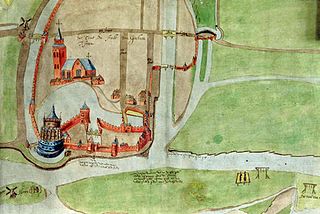
The Blue Tower was a castle with an imposing stone keep in Gorinchem, the Netherlands. It was a princely residence of Charles the Bold, Duke of Burgundy. The complex, which stood there between 1461 and 1578, gained an almost mythical status thanks in part to descriptions by the Gorinchem chronicler Abraham Kemp and the discovery of its foundations in 1983.


















